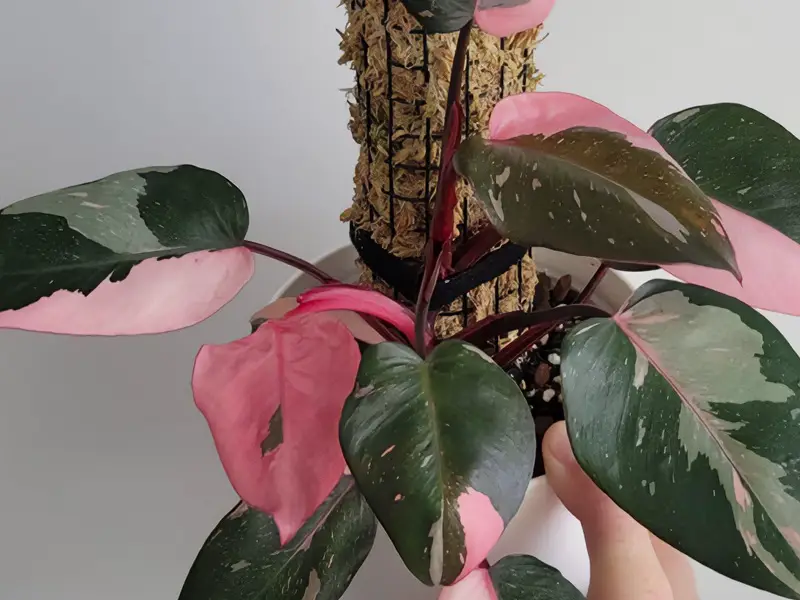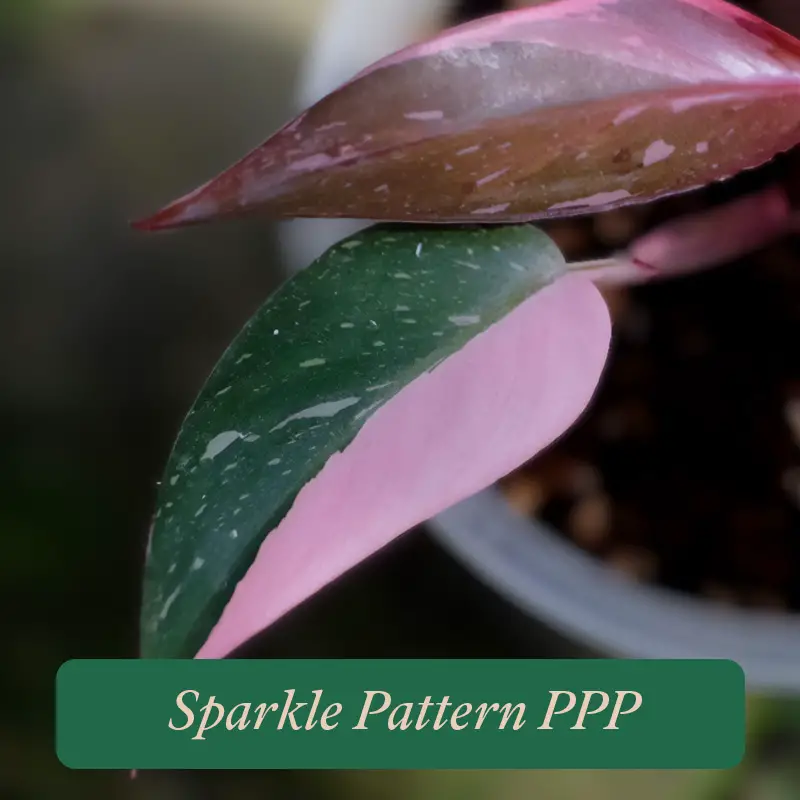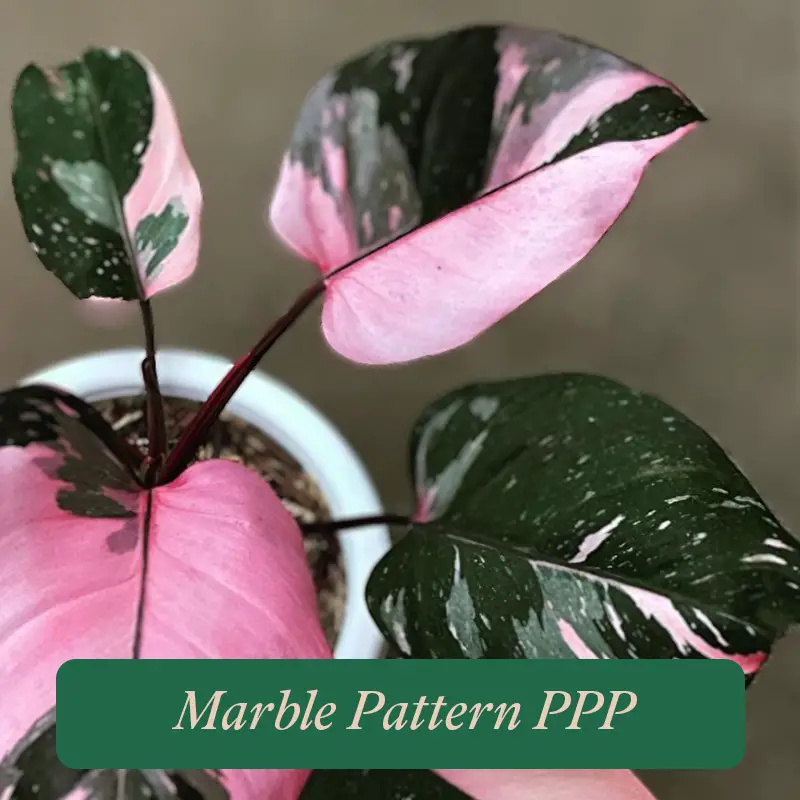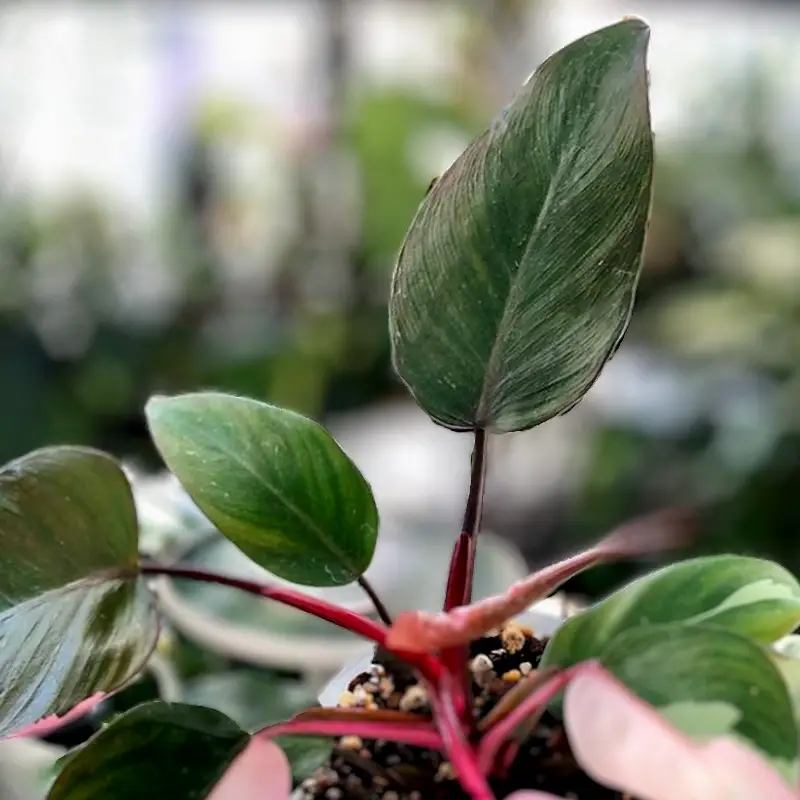
The Pink Princess Philodendron was one of my first Philodendron collections. It was love at first sight, and I immediately knew I had to get it despite the ridiculous price tag!
The Pink Princess Philodendron plant is so expensive because it’s a highly sought-after and beautiful plant. However, it’s difficult for growers to produce one with a balanced pink and green variegation, making the variation rare. The plant’s popularity, rarity, and low supply make it so expensive.
In this article, I will explain in detail everything you need to know about Pink Princess Philodendron (PPP):
- Is the Pink Princess Philodendron rare?
- How much does a PPP cost?
- Variety of patterns on the PPP
- My tips on caring and maintaining PPP
- Can a PPP revert and how to encourage its variegation?
- Other Philodendron variety with pink leaves
Is the Pink Princess Philodendron Rare?
Pink Princess Philodendron is considered rare. Many people want them for their unique dark green and bubblegum pink, variegated leaves. However, getting their pink leaves is not easy, making the plant rare.

Pink Princess Philodendron plants often have many pink spots, making them beautiful houseplants. Their unique, heart-shaped, and variegated leaves also add to their character and striking visual impression.
Despite its name and attractive appearance, the Pink Princess Philodendron plant is relatively easy to maintain, making it ideal even for beginners.
How much is a Philodendron Pink Princess?
First-time Pink Princess Philodendron buyers are often surprised to see the high price tag of this well-loved plant. The high cost of Pink Princess Philodendron plants is due to their popularity and scarcity.
It can cost between $45 and $125 for a Pink Princess Philodendron cutting without a pot. Larger Pink Princess Philodendrons sold with matching pots are the most expensive, while reverted plants (with little or no pink spots) are the most inexpensively priced.
Here is a basic guide to Pink Princess Philodendron plant pricing:
| Description | Price |
| Pink Princess Philodendron cutting without a pot | Between $45 and $125 |
| Mature Pink Princess Philodendron with a matching pot | Up to $300 |
| Reverted Pink Princess Philodendron | Less than $10 |
Pink Princess Philodendron enthusiasts often find that dealing with a reputable collector who sells offcuts can be an excellent option.
Collectors typically only sell Pink Princess Philodendron plants when they have matured slightly. This is in order to check that the plant’s leaves have enough pink spots.
Sparkle vs. Marble Pattern: Difference and Which Is More Expensive
The Pink Princess Philodendron plant comes in a range of varieties. Two of the most popular Pink Princess Philodendron plant varieties are sparkle and marble.


The sparkle variety is also known as the common Pink Princess Philodendron, which is the most widely available variety and isn’t as expensive as the marbled plant.
The sparkle Pink Princess Philodendron gets its name due to the spark-like flashes of bubblegum pink on the plant’s leaves.
The marble Pink Princess Philodendron (or Philodendron erubescens) has large, waxy leaves. It’s similar to the sparkle variety but, as its name implies, has a marbled pink pattern on the leaves.
Marble Pink Princess Philodendron plants have more pink color patches on the leaves, and their pink color pattern is more uniform. Their appearance makes them more desirable than sparkle Pink Princess Philodendrons, hence the higher price.
An immature marble Pink Princess Philodendron costs just under $300, while a small sparkle plant can cost only $35 to $45.
Maintaining Care for Pink Princess Philodendron
If you maintain your Pink Princess Philodendron correctly, it can bring you many years of joy.
The optimal conditions for Pink Princess Philodendron are places with low, indirect light and plenty of humidity. If your home typically has dry air due to heating or air conditioning, consider gently misting your Pink Princess Philodendron with water once or twice a week.
You should water your Pink Princess Philodendron once a week, ensuring that the upper inch of soil is completely dry before re-watering. Adequate drainage in the plant pot is essential in preventing oversaturation, and a few drainage holes in the pot can help.
Mixing perlite or orchid barks in the soil can also promote good drainage.
Consider using a high-quality fertilizer to add to the soil during the plant’s growing season. It promotes healthy growth and bright colors.
Remember that since Pink Princess Philodendrons don’t have as much chlorophyll as plants with solid green leaves, their growth rate is slower.
If your Pink Princess Philodendron’s leaves are falling off or curling, it’s a sign of underwatering. Yellowing leaves that appear limp could be a sign that you’re overwatering the plant.
If the leaves have too much or very little pink, that means the plant isn’t healthy. In such cases, you might want to prune the plant half an inch above a variegated leaf to encourage healthy leaf growth.
Can a Pink Princess Philodendron Revert?
Pink Princess Philodendron plants can sometimes lose their leaves’ pretty pink color spots, their signature feature.
This is known as reversion and, when this happens, the leaves will no longer be variegated.

A Pink Princess Philodendron can revert, and this is a reaction to stressful conditions, such as extreme heat, cold or bright light conditions. If the plant is placed in a pot that is too large or there is no adequate drainage in the soil, this can also cause it to revert.
How Do You Encourage Variegation Pink Princess?
Variegation in leaves refers to color diversity. In the case of the Pink Princess Philodendron plant, a well-variegated individual means that there is a balance of pink and green in the leaves.
Ensure that your Pink Princess Philodendron receives adequate, indirect sunlight to encourage optimal variegation. East or west-facing windows are best as they receive the correct amount of indirect sunlight that the plant needs for healthy growth.
If your east or west-facing windows don’t offer sufficient sunlight, you could use a grow light at a low setting for a couple of hours each day.
Or, prune the plant below the last variegated leaf. Doing so will encourage new leaves to have pink color spots.
How Do You Keep Pink Princess Philodendron Pink?
Most people invest in Pink Princess Philodendron plants due to their iconic dark green and pink leaves.
The pink color in the heart-shaped leaves is the most desirable aspect of the Pink Princess Philodendron plant. Therefore, it’s understandable to become concerned that your plant maintains its pink color.
Remember that the green leaf sections contain chlorophyll (while the pink spots have none). Chlorophyll helps the plant absorb energy from sunlight and keeps it healthy.
Leaves that are entirely pink will eventually die and fall off.
If your Pink Princess Philodendron plant’s leaves contain pink spots with plenty of green, it’s a sign that it’s healthy.
Ensure your Pink Princess Philodendron plant receives plenty of bright, indirect light to keep it pink. Direct sunlight dries the leaves out, turning them yellow, so finding a place with mild light conditions is best. A temperature between 60°F (16°C) and 85°F (29°C) is optimal for healthy leaves.
Other Varieties of Pink Philodendrons
The Pink Princess Philodendron plant is a mutation of the Blushing Philodendron (or Philodendron erubescens).
Pink Princess Philodendrons, in turn, have further mutations. The differences in the mutations can be seen in the leaf colors and degree of variegation.
Below are the most popular Pink Princess Philodendron varieties:
Philodendron Pink Congo
Pink Congo Philodendron plants have recently enjoyed much popularity due to their brightly-colored pink leaves.

Unlike the common Pink Princess Philodendron plant, this variety doesn’t have variegated leaves. Instead, its leaves are either wholly green or entirely pink.
Since they don’t contain any chlorophyll, the pink leaves eventually die and fall off, leaving you with a green-leaved plant.
Philodendron Black Cherry
The Black Cherry version of the Pink Princess Philodendron plant has leaves in a darker shade of green than that of the common Pink Princess Philodendron plant.

Instead of having bubblegum pink color spots on the leaves, the Black Cherry variety has purple or cherry-colored areas.
Also known as Galaxy Pink Princess Philodendrons, Black Cherry plants are scarce and can cost up to $250.
Philodendron Strawberry Shake
The Strawberry Shake philodendron plant is another attractive houseplant.

It features a dark red stem with variegated leaves. The leaves’ base color is bright green with variegated color spots: deep crimson, bubblegum pink, beige or bright white.
Strawberry Shake philodendron plants do well when allowed to climb, and you should encourage this by winding new leaves around a slender moss pole.
Why Is My Pink Princess Plant Not Pink?
It can be frustrating when your Pink Princess Philodendron doesn’t exhibit its trademark pink color (a beautiful contrast to the bright green leaves).
Your Pink Princess Philodendron plant isn’t pink because it’s healthy. Leaves that are entirely pink aren’t good as they indicate that the leaves don’t contain enough chlorophyll for energy and growth. It’s normal for a Pink Princess Philodendron plant not to have entirely pink leaves.
Why Is the Philodendron Pink Princess So Expensive?
The Philodendron Pink Princess is so expensive because their unique leaf pattern and color combination make them highly sought-after houseplants. Also, it’s challenging to grow these plants, and demand often outweighs supply. Their slow growth rate means that it’s not easy for growers to have a lot of stock.
What Is the Rarest Philodendron?
It’s difficult not to admire the beauty of any philodendron plant. All philodendron plant varieties are considered rare.
The Philodendron Spiritus Sancti is the rarest philodendron. Grown in Espirito Santo, a Brazilian state, it boasts uniquely-shaped pendant leaves. Only a few of these special plants remain in the wild, and they’re now considered endangered, the reason they’re so expensive and popular.
Also read:
